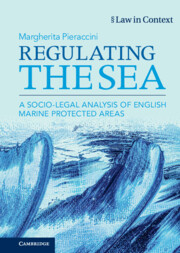Book contents
- Regulating the Sea
- Law in Context
- Regulating the Sea
- Copyright page
- Contents
- Preface and Acknowledgements
- Table of Cases
- Table of Legislation
- Abbreviations
- Introduction
- 1 The Geography of Regulation
- 2 Multi-level Regulation of English Marine Protected Areas
- 3 Impact Assessments for Marine Protected Areas
- 4 Risk-Based Regulation
- 5 Marine Conservation Zones Designation
- 6 Environmental Democracy in Marine Protected Areas Management
- 7 Climate Change and Marine Protected Areas Network
- 8 Marine Protected Areas Regulation in the Context of Regulatory Uncertainty and Change
- Concluding Remarks
- Bibliography
- Index
6 - Environmental Democracy in Marine Protected Areas Management
The Role of Inshore Fisheries Conservation Authorities and Environmental NGOs
Published online by Cambridge University Press: 15 December 2022
- Regulating the Sea
- Law in Context
- Regulating the Sea
- Copyright page
- Contents
- Preface and Acknowledgements
- Table of Cases
- Table of Legislation
- Abbreviations
- Introduction
- 1 The Geography of Regulation
- 2 Multi-level Regulation of English Marine Protected Areas
- 3 Impact Assessments for Marine Protected Areas
- 4 Risk-Based Regulation
- 5 Marine Conservation Zones Designation
- 6 Environmental Democracy in Marine Protected Areas Management
- 7 Climate Change and Marine Protected Areas Network
- 8 Marine Protected Areas Regulation in the Context of Regulatory Uncertainty and Change
- Concluding Remarks
- Bibliography
- Index
Summary
This chapter discusses environmental democracy from an institutional perspective focusing on the role Inshore Fisheries Conservation Authorities and environmental NGOs have in marine conservation regulation. Environmental NGOs are the ‘usual suspects’ when discussing environmental democracy. They are the voice of the more-than human, operating as a proxy, and they are defending the environmental rights of present and future generations through a variety of strategies, more or less confrontational. Thus, NGOs are an obvious subject in discussions of environmental democracy. For radical scholars, Inshore Fisheries Conservation Authorities may seem less interesting. After all, their transformative potential is tamed by the statutory obligations governing their behaviour, they are local arms of the state. However, the chapter reveals that their set up and operation display important democratic aspects. Although both organisations contribute to the democratisation of regulation, they also experience some challenges and constraints, which the chapter discusses.
Keywords
- Type
- Chapter
- Information
- Regulating the SeaA Socio-Legal Analysis of English Marine Protected Areas, pp. 110 - 127Publisher: Cambridge University PressPrint publication year: 2022

